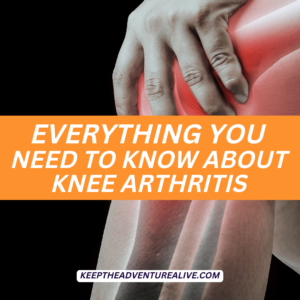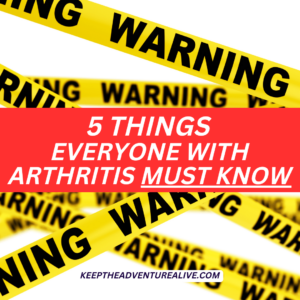When dealing with arthritis pain, it can be difficult to enjoy a walk on the beach if your joints aren’t prepared. You can actually enjoy walking in the sand though with the proper strength and balance. Research has actually shown walking in sand has many benefits both physically and mentally. I mean who wouldn’t want to enjoy a nice walk on the beach? This article will show the top three movements to help prepare your muscles and joints to handle walking in the sand without paying for it later.
If you are preparing for a beach vacation or simply want to enjoy walking on the sand, I’m really glad you’re here. Many people do not prepare properly for walking in the sand and end up with increased arthritis pain, swelling, or an injury that detracts from the enjoyment the beach can bring.
I just returned from a beach vacation and two guests that were with us experienced calf pain and foot pain from walking and running along the beach.
Many people simply avoid sand entirely due to fear of falling and/or pain.
Sand can actually have more benefits than walking on flat ground. Learn more about the benefits here.
When it comes to preparation, you first have to look at what is required to have a successful walk on the beach. Once you understand what’s needed and execute proper training, anything is possible!
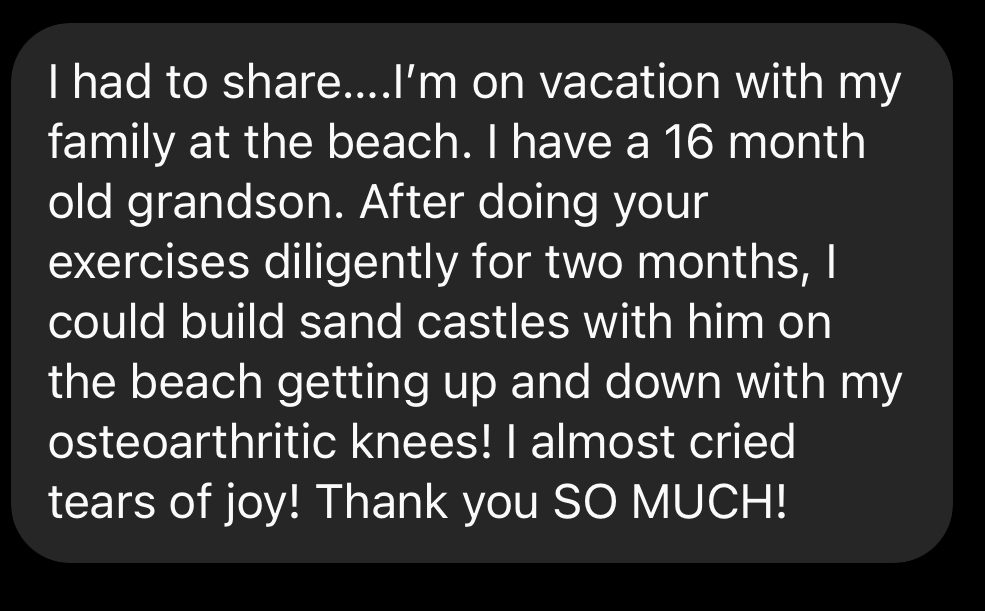

If walking on the beach or walking on sand is difficult for you right now- I want you to know if it is possible to enjoy that again.
It truly is amazing what you can accomplish when you have the right steps forward to help you build both strength and balance as well as strategies to continue to reduce inflammation.
A member of Adventurers for Life had a recent win where she was able to enjoy the beach because she had built up the adequate strength and balance to support her joints!
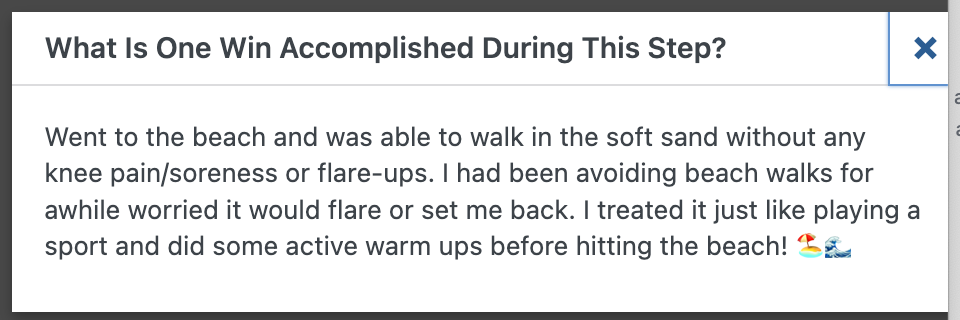
As a physical therapist, I often hear from people with osteoarthritis that they have written off ever being able to travel due to obstacles such as stairs, lots of walking, and walking on uneven ground such as sand.
It is possible to make these activities not only possible but safe and less painful!
Here is an article about how to enjoy traveling with bone on bone knee arthritis in particular that you can head to after finishing this article.
How your body works in the sand
If you have ever walked in the sand before, you may have realized that your walking pattern can change due to the change in surface.
If you haven’t walked on sand before, think about walking on a soft, squishy, unpredictable surface. Imagine how your walking may change.
The deeper the sand, the softer and more unpredictable it becomes.
You can probably see how this can challenge your balance. Walking on uneven surfaces requires the muscles and joints in your feet and ankles to work harder to keep you upright, along with your core.
You need the muscles in your feet, particularly near your arch to be strong and stable to avoid excess stress going to commonly injured areas such as your plantar fascia (typically inflamed in a condition called plantar fasciitis).
Your leg muscles have to be stronger as well because on uneven surfaces, the muscles in your leg have to work together to maintain balance as well. This is why walking in the sand can feel hard
You also need your calf muscles to not only be strong but also have a high level of stamina. This is because as your foot sinks in the sand, you need more power from your calf muscles to propel you forward. If your calf muscles fatigue quickly, more stress can go to other areas such as the achilles tendon which is the thick band that connects your calf muscle to your heel.
You cannot walk in the sand without forgetting to prepare your hip muscles too! Your glute muscles (i.e the muscles in your buttocks) help with balance along with helping to reduce limping.
The key aspects to focus on include:
- balance on uneven surfaces
- foot, ankle, core and leg strength to keep yourself upright
- calf strength and stamina to propel yourself forward
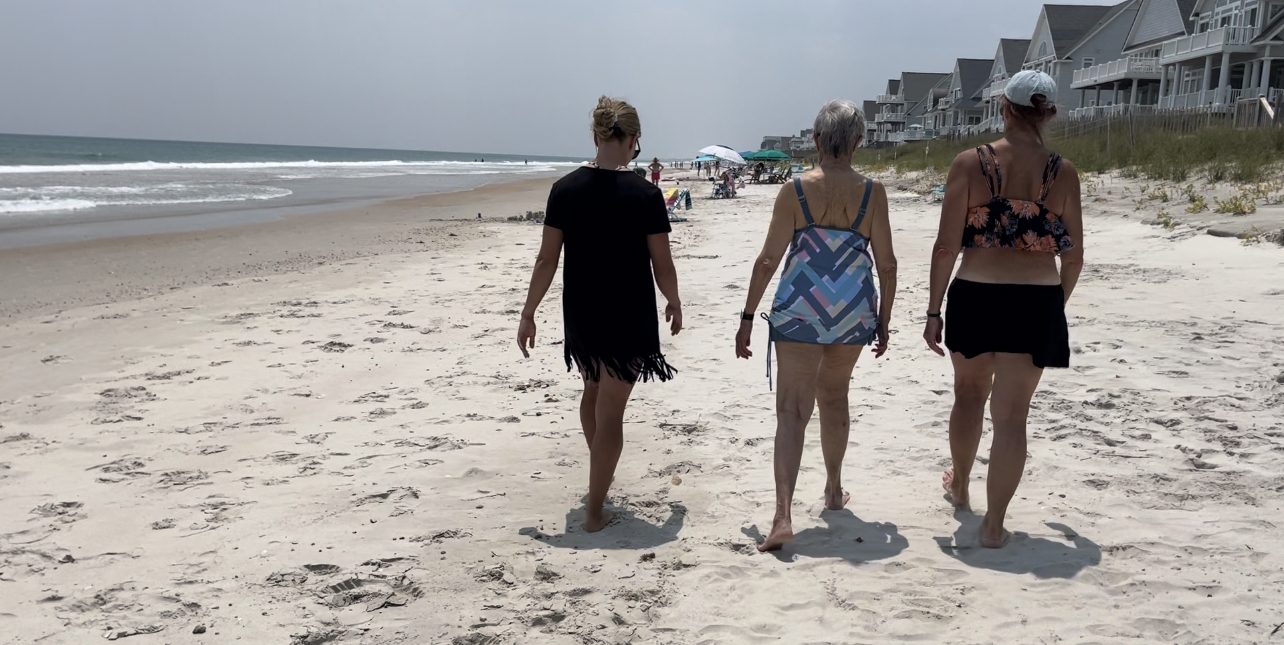
Exercises to help walk on the beach
In order to build strength in the right areas and to prepare your arthritic joints for the sand, here are some of my favorite exercises.
The idea is to choose 1 or 2 of these moves below to start with, as long as they feel good to you. If they cause significant pain, your joint(s) is/are simply not ready yet and that’s okay!
Some options for modifying include:
- using upper body support from a kitchen counter or other stable surface
- reduce the range of motion (i.e the size of the step)
1. Forward and backward stepping
This movement can be very helpful for both balance and stability in your entire leg as well as your foot which are very important during a walk on the beach.
The idea is to avoid allowing your stationary foot to collapse inwards. Try to maintain the arch in your foot. Keep your knee aligned over your ankle and avoid allowing it to go inwards.
Think about keeping the weight in your heel on the stationary side to allow more activation of the hip.
The larger step you take, the more difficult it will be on your balance.
If you’re feeling yourself wobbling too much, leaning to one side, or experiencing significant pain- try adding upper body support first.
Try for 10-20 repetitions on each side to start and increase repetitions once you feel more confident.
2. Single leg calf raise
Like we discussed earlier, calf strength and stamina are incredibly important to propel you forward when walking in sand.
Typical heel raises also known as calf raises usually include raising your heels off the ground with the balls of both feet on the ground. Raising both heels at once can feed into subtle compensations that you may not notice.
⚠️ Please make sure you can do double leg calf raises for at least 10 repetitions before attempting a single leg calf raise.
A single leg calf raise can help to highlight if there is a strength imbalance between the right and left side, meaning one side is stronger or weaker than the other.
Try 5-10 repetitions on each side to start and see if you notice a difference. This can then be a great exercise to build up strength in your calf muscles.
3. Staggered Deadlift
This exercise helps to work the hip muscles as well as your balance. When walking in the sand, if you notice you start limping, you’re taking smaller steps, or if you have an aching in your hip- this exercise may be what you need.
I like the staggered stance because it not only challenges one side of your body more than the other but it also adds a balance challenge.
In a regular deadlift, your feet are typically in line. Again, you may be making subtle compensations that you might not even notice. Switching to a staggered stance can highlight if there is a difference between sides.
If there is a difference, it’s important to work to close the gap or else walking in sand may be very difficult.
Try with a light weight first (1-5lbs) to make sure it feels good and to hone in on form. Once you feel confident and without pain, you can increase the weight as appropriate. complete 5-10 repetitions on each side to start.
Make sure to keep your knees relaxed and push your hips back, instead of bending at your spine. If you bend at your back, you may feel excess stiffness or pain in your back. If you do feel this- it’s important to look at your form, a mirror can be very helpful for this.
Enjoy a walk on the beach with arthritis
It is vital to prepare your joints if you plan on heading to the beach or walking in sand. If you don’t, you could experience increased pain and swelling.
It’s best to start a month or two before leaving for vacation or before getting ready to enjoy the beach and sand. Choose 1 or 2 of these movements above to start with and progress as you build more tolerance.
Looking for more help to reduce arthritis pain and make the the most of your future adventures?
You are not alone!
I have created a 3 Day Free Walking Workout Challenge to help you get started on improving walking strength, balance and stamina so you can enjoy walking wherever and with whomever you’d like! You can sign up for this challenge here:

If you are looking to regain your active life but are unsure where to start, join the revolutionary membership, Adventurers for Life. This is a step-by-step path that not only will help you find pain relief but will help you unlock adventure. You’ll get workouts, tests to pass to make sure you are on the right track, community events and MORE.
Alyssa Kuhn
Disclaimer: This post is for general informational purposes only. It should not be used to self-diagnose and it is not a substitute for a medical exam, cure, treatment, diagnosis, and prescription or recommendation. It does not create a doctor-patient relationship between Dr. Kuhn and you. You should not make any change in your health regimen or diet before first consulting a physician and obtaining a medical exam, diagnosis, and recommendation. Move Well Age Well, LLC and Dr. Alyssa Kuhn, PT, DPT are not liable or responsible for any advice, course of treatment, diagnosis or any conclusions drawn, services or product you obtain through this post, video or site. Complete all exercises at your own risk.

